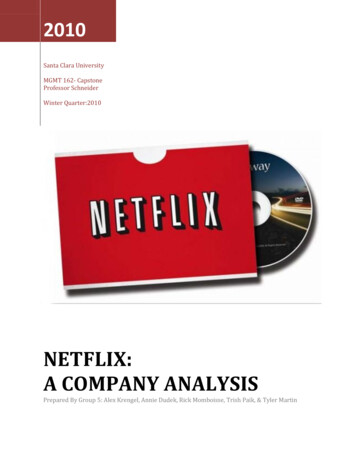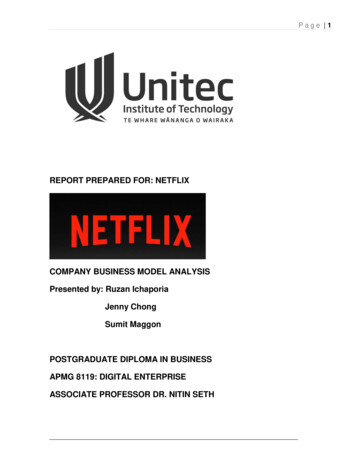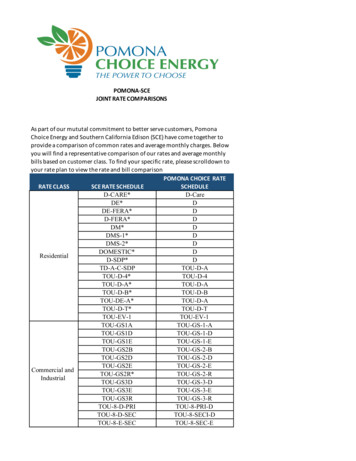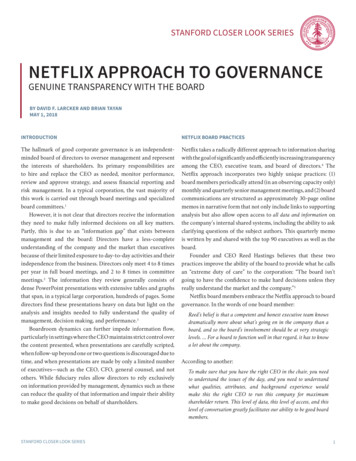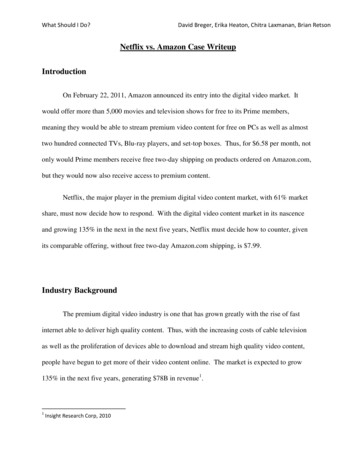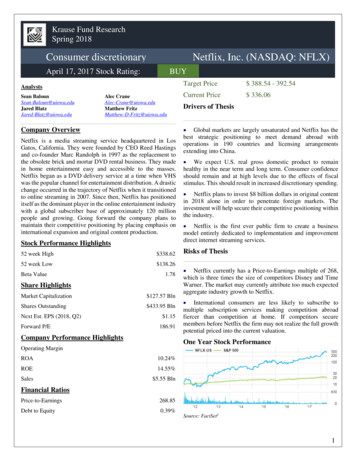
Transcription
Netflix, Inc.Client ReportDanger Zone ConsultingJonathan LewTravis Patrick BowersJohn WeissProfessor Likens Senior Seminar
Table of ContentsExecutive Summary . 3Company History & General Information . . .4Financial Analysis 6Overview . .6Revenue and Profitability 7Balance Sheet Analysis 8Cash and Liquidity . 9Stock Performance and Valuation . . . .105 Forces Analysis . 13Intensity of Existing Competition. .13Threat of New Entrants .13Threat of Substitute Products .14Bargaining Power of Suppliers .15Bargaining Power of Consumers . .16SWOT Analysis .17Strengths 17Weaknesses 18Opportunities .19Threats 20Strategic Recommendations .222
Executive SummaryNetflix brought on DangerZone Consulting to advise on an expansion strategy that would be themost impactful and reap the most results in the uncertain, convoluted online entertainmentstreaming industry. To do so, DangerZone Consulting first conducted a financial analysis ofNetflix for the fiscal year 2013, gauging stock performance, profitability, and overall financialhealth. DangerZone also assessed the state of the online entertainment streaming industry aswell as its future direction, investigating both threats and opportunities. DangerZone hasdetermined that the financial strength of Netflix and the shifts in the industry present a host ofopportunities to reinforce Netflix’s position as the market leader and continue to growexponentially. DangerZone has developed a set of actionable proposals for your consideration.Our strategic recommendations for Netflix focus on strengthening the core business, increasingthe number of subscribers and targeted global expansion. Netflix must focus on vertical andhorizontal integration, which means creating more original content under the Netflix name andbundling with other home entertainment systems in a bid to attract more subscribers. Thecompany should also update their catalog to make sure it contains the latest movies and TVshows as a common complaint about Netflix is its dated catalog. Lastly, we draw from thelessons of your Latin American expansion to form a set of conditions for countries which Netflixwould thrive in. We feel that countries within the European Union (EU) and India might be twogood places to expand internationally, as these regions have the infrastructure, economic andpolitical climate to support the introduction of Netflix.3
Company History and General InformationNetflix is a provider of on-demand internet streaming media available to viewers in North andSouth America, the Caribbean, and parts of Europe. Netflix occupies a unique place in themedia industry - aggregating, distributing, and recently creating its own content through anonline platform that lets viewer choose when and where they want to watch television shows ormovies. Subscribers pay US 7.99 per month for this right1. Its disruptive business model hasproven popular among younger users, whose lives are increasingly spent on their personalcomputers.Netflix began as an online DVD mail order company, allowing customers to select DVD titlesonline and receive them via Permit Reply Mail. Netflix has since moved on to providing ondemand Internet streaming entertainment across a wide variety of genres, though it stillmaintains its DVD rental business.Netflix, Inc. was established in 1997 by founders Marc Randolph and Reed Hastings (presentCEO) who had previously worked together, and its headquarters are at Los Gatos, California.The Netflix website was launched on August 29th 1997 with only 30 employees and 925 titlesavailable for rent, with a per-title rental cost model. It moved to a monthly subscription conceptin 1999, building its reputation on the business model of flat-fee unlimited rentals without duedates, late fees, shipping and handling fees, or per-title rental fees.Netflix had its IPO on May 29th 2002, selling 5.5 million shares of common stock at US 15 pershare. On June 14th 2002, Netflix sold another 825,000 shares at the same rice. Netflix postedits first profit during 2003, earning 6.5 million profit on revenues of 272 million.By 2005, 35,000 film titles were available and Netflix shipped close to 1 million DVDs everyday. It had developed an extensive personalized video-recommendation system based on1Note: As of April 22th 2014, CEO Reed Hastings has announced plans to increase subscription fees by 1 or 2.4
reviews and ratings by customers, and currently uses the same algorithm in predicting customers’preferences.In February 2007, the company delivered its billionth DVD and began to move towards Videoon-Demand via internet streaming, which it saw as the future of media and entertainment. DVDsales fell from 2006 to 2011. By 2010, Netflix’s streaming business had grown to the extent thatthe company shifted from being the fastest-growing customer of the USPS’s first-class mailservice to the biggest source of internet traffic in North America in the evening.On September 18th, 2011 Netflix revealed plans to split off their DVD-rental section and renameit Qwikster, where users would have to use a separate website to access Qwikster. This receiveda negative reaction from many customers, and Reed Hastings quickly announced the cancellationof the planned Qwikster service on October 10th of the same year.Netflix has exclusive pay-TV deals with major and mini-major movie studios. Select titles fromRelativity Media, DreamWorks Animation, Open Road Films, FilmDistrict, The WeinsteinCompany and Walt Disney Studios Motion Pictures are only available through Netflix. Otherstudios providing content on Netflix under license include Disney–ABC Television Group,DreamWorks Classics, Kino International, Warner Bros. Television, 20th Television, HasbroStudios, Saban Brands and CBS Television Distribution.In 2013, Netflix was the first company to acquire and release original content for its subscriptionstreaming service with the political drama House of Cards, which debuted in February 2013.This was a landmark event because all 13 episodes of the drama were released at the same time,reinforcing the notion that the average American TV viewer was inclined to “binge-watch”episodes, as opposed to the traditional weekly release of a single episode. Currently, Netflix hasten original series in its library, with Emmy and Academy Awards nominations and wins formany of its series.As of 2014, Netflix reported 33.1 million US subscribers, and around 44 million globally.5
Financial AnalysisOverviewSelected Valuation MetricsMarket CapitalizationTrailing P/EForward P/E (Dec 31, 2015)Price/BookCurrent RatioDebt/EquityEPSBetaEBITDAROEROAProfit MarginNetflix, 10.82%3.04%2.57%As of April 14th 2014Netflix’s financials reflect a strong, profitable company in a booming industry. Netflix hasproved its staying power in the industry and can be considered the market leader in the onlinestreaming media entertainment industry. As of April 14th 2014, Netflix trades at 326.71 and hasa market cap of 19.54 billion. The company’s IPO in 2002 saw shares sell for 15, whichshows how much Netflix has grown since and the optimism and faith of investors and analysts inthe company and its management. Netflix has a lot of cash on hand and healthy cash flows tosupport its expansion. The only concern is the high P/E valuation, but this is typical of techcompanies.Netflix has experienced another strong fiscal year and continued an upward trend in financialgrowth. The company has continued to see revenues rise at remarkable rates over the past 5years, at an average growth rate of nearly 32% per year. This seemingly unsustainable growthcan be attributed to the expansion of the Netflix streaming user base. Over the same time period,Netflix has seen its user subscriptions increase from 12.3 million to over 44 million members.Most of this increase has been domestic, but Netflix now reaches approximately 10 millionmembers internationally.6
Fifteen years ago there was no such thing as online TV. The online streaming industry is youngand Netflix is its trailblazer. In terms of competitors, Amazon’s subdivision Amazon Primeprovides the same streaming service of shows and movies. However, any financial comparisonbetween Netflix and Amazon Prime would prove challenging, as separating Amazon Prime fromAmazon in the financials is difficult. In reality, Netflix’s biggest competitor are illegal streamingsites that allow users to download media content for free. Overall, analyzing Netflix’s financialsalone provides enough evidence for Netflix’s financial health.Revenue and ProfitabilitySource: Netflix Annual Report, 2013Netflix finished strong, posting net gains of earnings in both Q4 and the fiscal year of 2013. Byseeing an increase in online subscriptions of nearly 4 million members, Netflix continued itsgrowth and posted fourth quarter earnings of nearly 1.175 billion; an increase from the 1.105billion mark seen in the third quarter of 2013. Both of these values are substantially higher thantheir previous counterparts, when Netflix brought in 905 million and 954 million in the thirdand fourth quarters of 2012, respectively. The past two years’ financials show Netflix’s revenuesincreasing at a stable rate with the potential for sustained short-term and long-term growth.With the total user base hovering around 44 million, Netflix saw its yearly revenue streamincrease by nearly 22%, soaring from 3.6 billion in 2012 to nearly 4.4 billion in 2013.Additionally, operating and net income saw huge jumps between 2012 and 2013; operatingincome increased from 49 million to 228 million while net income rose from 17 million to7
nearly 112 million. While these increases appear to be unsustainable, they must be noted as asign of the popularity of online streaming and the direction of the media-entertainment industrytowards the internet as a viewing medium. As a more general comparison, in 2012 Netflix sawan increase of 400 million in total revenue from 2011, but nearly a 300 million and 200million loss in operating and net income, respectively. These inconsistencies are explainedthrough Netflix’s expenses. Netflix committed to expanding their product by starting to producetheir own TV shows as well as attempting to further develop their international presence.Endeavors like these caused Netflix’s costs to be abnormally high, as these projects have highinitial costs.For fiscal 2013, Netflix managed solid returns with a 10.82% and 3.04% return on equity andassets, respectively. Both of these numbers are strong, but are below industry averages. TheCATV industry average for return on equity is an astounding 45.7%. These numbers can bemisleading however as the CATV industry includes companies such as Comcast, Time Warner,and DirecTV, which are all cable providers and have large revenue streams from channel andsports contracts, thereby making any comparison with Netflix unfair. This issue is exacerbatedwhen comparing Netflix’s modest 2.57% profit margin to the industry average of 11.0%.Historically, Netflix hovers around a 9% profit margin. The company appears to be headingback to these strong levels as Netflix has seen its profit margin steadily increasing over the past 2years.Balance Sheet AnalysisSource: Netflix Annual Report, 20138
Over the past year, Netflix has seen a substantial increase in total assets. Netflix ended 2012with 3.967 billion in total assets and managed to increase that value to 5.41 billion at the endof 2013. Most of this increase resulted from a 500 million increase in non-current contentlibrary assets. Still, Netflix saw nearly a 1 billion dollar increase in total current assets, most ofwhich came from significant increases in cash as well as content ownership.Liabilities increased by nearly 800 million to a total of 4.075 billion in total current liabilities.The large growth in content ownership not only accounted for the asset increase but also foraround 450 million of the liability increase. In addition to content ownership, Netflix also added 500 million in long-term debt and plans on accumulating 400 million more in the first quarterof FY2014, mostly for use in acquiring and creating more content. Netflix raised 600 million instockholder equity predominantly from common stock equity increases.Cash and LiquidityNetflix currently operates with 1.2 billion in cash, which equates to 20.7 cash per share. In thepast year, Netflix received nearly 98 million in cash from operating activities. Combining thesecash figures with a low debt value of 530 million, Netflix currently operates with 2.43 billionin levered free cash. By constantly being pressured to expand to maintain a competitiveadvantage, having such an abundance of levered free cash is key. This enables Netflix to pursueideas at will without any concern of lingering debt or liquidity issues. Netflix's current ratio ofassets to liabilities sits at 1.42. Once again, this value suggests that Netflix is healthy and able tofinancially handle any issues that may arise.Source: Netflix Annual Report, 2013Net cash provided by operating activities was 97.8 million in FY2013. In FY2012, net cashfrom operating actives was a lowly 21.5 million. The largest contributor to this substantialincrease was an increase in net income. Net income in FY2013 was 95 million more than9
FY2012. Once again, the high startup costs of original productions caused Netflix to have a lessthan stellar FY2012, but the company is by no means is in a weak position financially. Netflixalso added nearly 120 million in cash flows from the issuance of common stock. Afterrecognizing only 4 million in proceeds from common stock in FY2012, Netflix received 124million from issuing common stock in FY2013, a significant increase.Netflix is strapped with cash. After expending significant amounts of cash into original contentproduction in 2012, Netflix reaped the benefits and returned to its profitability in 2013. From acash perspective, in 2012 Netflix saw a net decrease in cash of nearly 217 million, but regainedall that was lost in 2013 with 314 million increase in cash and cash equivalents.Stock Performance and ValuationSource: Netflix Annual Report, 201310
Investors are probably pleased with Netflix's stock performance over the past few years. SinceOctober of 2012, Netflix has seen its stock price increase by nearly 517%, significantlyoutperforming the NASDAQ, S&P 500, and the S&P North American Technology Indexes.This indicates that Netflix has cornered a large portion of the market, taken advantage of itsposition as the trailblazer in this industry and continued to inspire confidence in investors andanalysts alike. Shares closed at 326.71 per share on April 11th, 2014 on the NYSE, giving it amarket cap of 19.54 billion.Recently however, Netflix has seen its stock price fall by nearly 100 per share in the pastmonth. DangerZone speculates that the rumor of a potential Apple and Comcast partnership hastaken its toll on Netflix's stock. Apple currently has a product known as Apple TV, whichactually has Netflix embedded in the program. Apple TV is meant to replace cable and provideusers with all the various streaming offerings (e.g. Netflix, HuluPlus, HBO Go) in one location.However, the rumor of a potential partnership between Apple and Comcast would result inAppleTV offering a streaming program directly from Comcast's cable network. By doing so,AppleTV would avoid all buffering issues and poor quality that Netflix has to deal with duringperiods of heavy traffic. The potential mega-partnership of Comcast and Apple has thusprobably seen investors shy away from Netflix, causing the stock price to drop significantly overthe past month.While Netflix's stock price may be falling, there is no reason to believe this will become apermanent trend. Netflix currently has a trailing price-to-earnings ratio of 176.50, suggestingthat investors still believe there is substantial room for growth; the forward P/E of 43.91 may bemore realistic and represent Netflix as being more stable. Netflix trumps the industry average forprice to earnings, with the Industry average currently residing at 22.60. Thus, even if Netflixwere to see its P/E ratio decline, they would still dominate the Industry average P/E. While thecomparison highlights Netflix's magnitude, comparing the P/E of Netflix to companies such asDirecTV and Comcast is not always insightful as Netflix is a tech company, which causesfinancial values to generally be geared toward growth potential and thus overvalued. Regardless,investors appear to believe in Netflix and its opportunity for growth with such high P/E ratios.11
The company also sits on a price-to-book ratio of 14.96, meaning that the stock price reflects 15times more value than Netflix's tangible assets. This high price-to-book ratio is verycharacteristic of tech companies as most tech companies’ assets lie in content and other webbased programs that are not tangible and have no monetary valuations alone. The tech companystandard is also seen in Netflix's beta value of 2.02. Almost all tech companies have betasgreater than 1 as these tech-based companies often have significant room for growth, but alsohave the greatest risk attached to them. Thus, neither Netflix's price-to-book nor beta value areout of place as they are a tech company with most of their value tied up in online content andother intangible assets.Overall, Netflix is financially stable with the potential for significant growth. Revenue streamshave been steadily increasing over the past few years and looks set to stay that way as Netflixcontinues to innovate and find new ways to attract new members to its already large user-base.12
Five Forces AnalysisForceIntensity of Existing CompetitionThreat of New EntrantsThreat of Substitute ProductsBargaining Power of SuppliersBargaining Power of ConsumersStrategic tensity of Existing CompetitionNetflix has shifted its focus away from DVD rentals to become primarily a provider of ondemand Internet streaming media. Netflix does not have many direct competitors, as its businessmodel is so broad and incorporates all levels of the media distribution chain: creation,aggregation, and distribution. Netflix’s main competitors in the online media industry includeAmazon Prime, Hulu, HBO Go and VZ-CSTR although none of these companies haveoperations that line up exactly with Netflix’s. Players in the market compete mainly amongprices, quality of content, and ease of use. Netflix has recently begun providing original contentto distinguish itself from competitors, and some of these series have gained national recognition.The online media streaming industry is growing quickly as technology advances and companieswill continue to try to offer the best and most recent content to consumers. Because the industryis growing quickly, there is plenty of room for all players to grow in the industry without intensecompetition.Threat of New EntrantsThe threat of new entrants is low, and should not pose a danger to Netflix’s online streamingservices, mainly because there are large barriers to entry. High capital costs are required in orderto obtain content and a strong distribution network, which prevent smaller companies fromentering the industry. Companies trying to enter the market need to be able to offer a variety ofhigh quality content online at fast download speeds, and this level of infrastructure is costly.However, larger companies, such as Apple and Google, have expressed modest interest inentering related markets, and these companies do have the capital requirements to threatenNetflix. Netflix does have a first-mover advantage, and is one of the best-known brands in the13
industry. The company will have to continue to innovate as technology improves to maintain itsposition as market leader.Threat of Substitute ProductsPhysical DVD rental and sales companies do not pose much of a threat to Netflix, as consumersprefer the low costs and instant gratification that come with online streaming. However, one verydangerous threat to Netflix is illegal pirating. There exist websites that allow customers to accessmost media content for free, although these sites are technically illegal. However, there is verylittle risk for customers who download content from these sites. The downside to illegalstreaming is that it can be somewhat complicated and is not nearly as intuitive as Netflix’sservice. However, there is a significant segment of Netflix’s potential market base that wouldrather illegally pirate content than pay the low membership fee. It is possible that governmentagencies might choose to enforce these anti-pirating laws more strictly, and substitute productswould then no longer concern Netflix. In fact, it may be in Netflix’s best interest to lobby fortighter enforcement of these laws because as it stands, illegal pirating poses one of the largestthreats to Netflix’s business model.Competition could also increase as networks and content providers improve their own Internetpresence and create their own content distribution applications as they try to cut out Netflixaltogether. Every major network is trying to improve their Internet applications on tablets, smartTVs, phones, game consoles, and laptops, just like Netflix has already done. They would like tocut out the middle aggregators such as Netflix and improve their own accessibility in order totake a larger share of the profits. Netflix provides value in that it aggregates so many contentproviders at a single source. However, if content providers can provide their own means ofInternet streaming, then they might begin restricting the content they sell to Netflix. Netflix’ssuccess depends on providing current, varied, and popular content to consumers, so if it is forcedtoward the end of the content life cycle, it might have to rely more on its original content, whichis not its core business and constitutes very little of its revenue.14
Bargaining Power of SuppliersThere are relatively few quality media content providers and thus few substitutes that Netflixcould deal with. In this respect, the bargaining power of suppliers is relatively high. Netflix hasrecently started developing its own content with its Netflix Originals, which have gained sometraction amongst viewers and received acclaim from the entertainment industry. However, mostof Netflix’s revenue is derived from its core product, aggregating and distributing media content.Netflix needs to maintain its breadth and variety of products, which makes the companydependent on its providers. Though Netflix’s subscriber base is growing, which gives it someleverage in negotiating terms, it is still at the mercy of these media providers for much of itsbusiness. For example, Netflix recently lost its contract with Viacom International, one of theleading content providers for popular children’s shows, which upset many parents who usedNetflix as a single source for their children’s television. In fact, Netflix lost this contract to itsrival Amazon Instant Prime. These content providers have extremely differentiated products,which often do not have close substitutes. Therefore it is critical that Netflix maintains goodrelations with its content providers, who would be happy to sell elsewhere. As a result, a largeportion of the industry profitability will go to the suppliers.Additionally, Internet Service Providers (ISPs) have bargaining power over Netflix, in that theycontrol Netflix’s bandwidth and streaming speeds. Strong bandwidth is essential for Netflix’soperations, as customers demand fast and uninterrupted streaming services. Currently, ISPs canforce large companies like Netflix to pay a premium by threatening to reduce their bandwidth.There has been a recent movement towards net neutrality, which argues that ISPs should view allweb traffic as equal and should not extract fees from large companies like Netflix that depend onhigh bandwidth and can pay a premium. The US still has not enacted net neutrality laws, whichmeans that Netflix has to pay US ISPs a premium for its high-quality bandwidth. Netflix’s recentdeal with Comcast was over bandwidth issues. In Europe though, net neutrality is more strictlyenforced which has lowered Netflix’s costs. At the same time, net neutrality also diminishessome of Netflix’s competitive advantage and levels the playing field for all website companies.Although Netflix paid a premium for high bandwidth, the premium also prohibited some15
companies from competing with them. It remains to be seen whether net neutrality movementswill help or hurt Netflix in the long run.As mentioned previously, every major network and content providers is trying to improve theirown Internet accessibility so that they can distribute content directly to consumers as well.Although Netflix does provide value by aggregating content, suppliers may begin to restrict thecontent they sell to Netflix if they believe they can distribute the content just as effectively andgain a share of the profits.Bargaining Power of ConsumersCustomers in the Internet media streaming industry do have significant bargaining powerbecause switching costs are so low, and customers are willing to change services quickly. Netflixcurrently charges a monthly membership fee of 7.99, which is extremely affordable. However,because customers are not locked into contracts for long periods of time, they are very pricesensitive and will choose other distributors. One strategy that Netflix has employed to limitcustomer bargaining power has been its original content creation. Netflix Original Series hasreceived much attention and acclaim, and most importantly cannot be found on other largedistributors. While most of content can be found on illegal pirating websites for free, manycustomers still would rather pay the low monthly membership fee and enjoy Netflix’s ease of usethan risk the legal consequences.16
SWOT AnalysisStrengths Proven Business Model Financially Stable Popularity Among Younger Generation Strong ManagementOpportunities Targeted International Expansion Increased Vertical and HorizontalExpansionWeaknesses Dependency on Content Creators Inconsistent, Outdated CatalogThreats Domestic and International RegulatoryThreats Bandwidth Regulation Illegal Downloads IndustryStrengthsNetflix has a proven business model in a rapidly-growing industry that makes it a market leaderin online media content distribution. Netflix stands alone in this regard, especially given that ithad a first-mover advantage in this industry. At 7.99 per month for unlimited content viewingon an unlimited number of devices, existing subscribers are unlikely to shift to a competitorwhile new users will be drawn to Netflix on the basis of its low cost (the average movie ticketcost 8.38 in 20132). Netflix provides one of the largest catalogs of movies and television showsonline, and its 33.1 million subscribers prove that its core business model remains stable. Thislarge subscriber base gives it leverage in negotiating deals with movie and television studios.Netflix’s strong financial health gives it the versatility to pursue opportunities in nearly anyaspect of the entertainment provider industry. Its latest venture, original TV programming, wereall paid easily with the 1.2 billion in cash reserves and the 500 million raised in 2013. Itshealthy cash flow also ensures that the company is in no danger financially, and as long as itsstrategy remains competitive, the company has the cash to experiment and innovate.In the last decade, users have increasingly spent more and more of their lives on their personalcomputer, tablets, and mobile devices. Especially among the younger generation, staying2Source: National Association of Theater Owners17
“connected” all the time is important in our daily lives, and more often than not people will havemore than one electronic device turned on at any given time. Online streaming of media contentoccupies a vital role in how the younger generation spends their free time, and the ability towatch entertainment videos on the go is becoming very important in this era. Netflix thus fulfillsthis role for many people, and the future of the entertainment industry looks more and morelikely to be online.Netflix’s strong management is a big strength, and its business decisions have proved this.Netflix was the first to recognize the potential of online entertainment streaming and capitalizedon it. Netflix recovered well from their Qwikster debacle in 2011, proving that yourmanagement team was listening to their users. The decision to produce original content was alsoa landmark for what is primarily a media aggregation and distribution service. In addition,releasing all episodes of a single season at the same time was again a first for any mediaplatform, and showed that management understood the current viewer’s preferences for “bingewatching” television shows. This decision paid off, as the popularity and success of televisionseries like House of Cards has given Netflix even more cachet in the industry.WeaknessesAs Netflix remains primarily a content aggregator and distributor, it remains beholden to themovie and television studios in terms of the content it can distribu
Price/Book 14.96 Current Ratio 1.42 Debt/Equity 39.79 EPS 1.85 Beta 2.02 EBITDA 276.72M ROE 10.82% ROA 3.04% Profit Margin 2.57% As of April 14th 2014 Netflix's financials reflect a strong, profitable company in a booming industry. Netflix has proved its staying power in the industry and can be considered the market leader in the online
